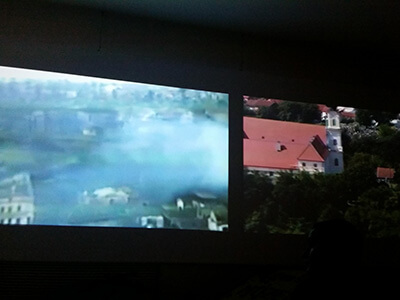
Vukovar
CZ/ENGWhat Happened At This Place?
Vukovar lies on the right bank of the Danube, right at the Croatian-Serbian border. It became the first European city since the end of the Second World War to be completely destroyed in a battle. This took place over the fall of 1991, when the Yugoslav People’s Army and Serbian paramilitary units besieged the city. The Croatian National Guard, along with other Croatian armed forces and civilians, defended the city. During the battle, tens of thousands of missiles fell on the area of Vukovar. Upon capturing the city, Serbs massacred hundreds of soldiers and civilians and expelled another 20,000 inhabitants. Slobodan Milošević, along with other military commanders, was later convicted of war crimes that they had committed during the Battle of Vukovar and immediately afterwards. Serbian forces killed about 200 people who had been hiding in the Vukovar hospital at the Ovčara farm, and another approximately 50 people disappeared to an unknown location. Later, people began calling this event the “Vukovar massacre.”
What Does This Place Look Like Today?
The grand majority of the city was rebuilt after the war. At first glance, only a water tower, which looks over the Danube as a memento of the battle and a clear declaration of the local politics of memory, reminds people of the Battle of Vukovar. This 50-meter tower is deliberately kept in the same state that it was during the siege. It is meant to be a reminder of the suffering and pain, but also a symbol of victory and a new life. There are also unintentional mementos of the past, like the dilapidated railway station from the time of the Habsburg monarchy, or the abandoned functionalist shoe factory, which the Czechoslovak Baťa group built on the outskirts of the city before the Second World War.
Until the outbreak of the war, Vukovar was a prosperous city in one of the richest parts of Yugoslavia. A diverse population lived here shoulder to shoulder, including Croats and Serbs. Its position on the periphery of Croatia today, however, means that it displays the problems facing the whole Eastern part of the country, primarily unemployment. Postwar Vukovar thus became a city in which many young people don’t have a view of the future and, because of that, want to leave it. It isn’t war or ethnic identity that expels them from Vukovar now, but rather economic reasons.
What Does This Place Serve As?
Vukovar definitely does not belong among the most frequented tourist destinations in Croatia. Still, there are several souvenir stands on the city’s main promenade. The themes of the commemorative items show what tourism in Vukovar is based on. Shirts, scarves, magnets, candles, and many other decorative items bear the motif of the Vukovar water tower, which became a symbol of the city’s capture in 1991. It appears as though kitsch can be both a way to make money and a way to reckon with the local traumatic past. The main regular visitors to Vukovar and potential customers for these stands are Croatian schoolchildren. A visit to the city on the Danube and the scene of the recent Croatian trauma is, actually, a required part of the school curriculum.
What Is (Not) Remembered Here?
It’s not only tourist stands that remind people of the Battle of Vukovar; there’s also a whole room in the city museum. In that room, there are authentic ruins from the bombarded city, along with aerial images of Vukovar from 1991 and today projected onto the walls. However, the main — and rather strange — place of memory is the exposition at the Vukovar hospital, which is both a museum and memorial. The exhibition and its installation function primarily emotionally-affectively, not explaining the causes of the ethnic conflict and creating the image of some unfathomable evil. In this presentation, evil isn’t something that a person can decisively carry out, but rather something that is essentially in him. The narrative creates a clear division between “us” and “them,” which the tour guide in the city museum also authoritatively confirms: “the Croats were the good guys, the Serbs were the bad guys.” The traumatic past in this case, then, does not become a place for reflection, but rather for building the national myth, upon which the political legitimacy of the current Croatian state stands. The victims become the heroes.



















